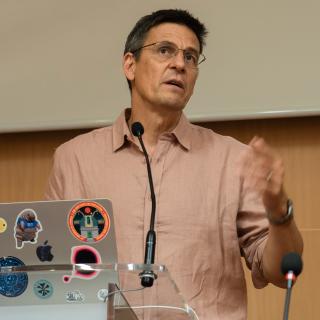It may interest you
-
 The Instituto de Astrofísica de Canarias (IAC) is positioning itself as one of the main partners of the Government of the Canary Islands in the Canary Islands Aerospace Strategy, presented this Wednesday by President Fernando Clavijo. The goal is to position the archipelago as a key player in a rapidly growing sector, promoting innovation, technology transfer, and the creation of high value-added jobs.Advertised on
The Instituto de Astrofísica de Canarias (IAC) is positioning itself as one of the main partners of the Government of the Canary Islands in the Canary Islands Aerospace Strategy, presented this Wednesday by President Fernando Clavijo. The goal is to position the archipelago as a key player in a rapidly growing sector, promoting innovation, technology transfer, and the creation of high value-added jobs.Advertised on -
 The Instituto de Astrofísica de Canarias (IAC) welcomed the visit of Professor Didier Queloz, Nobel Laureate in Physics and co-discoverer of the first exoplanet orbiting a Sun-like star. Professor Queloz's stay at the IAC has focused on instrumental development and technological collaboration. As part of his agenda, he also gave a lecture entitled ‘Exoplanets: the next frontier’ in the IAC Lecture Hall. The researcher visited the IAC to supervise the installation of a new high-stability spectrograph on the Isaac Newton Telescope (INT) at the Roque de los Muchachos Observatory on La PalmaAdvertised on
The Instituto de Astrofísica de Canarias (IAC) welcomed the visit of Professor Didier Queloz, Nobel Laureate in Physics and co-discoverer of the first exoplanet orbiting a Sun-like star. Professor Queloz's stay at the IAC has focused on instrumental development and technological collaboration. As part of his agenda, he also gave a lecture entitled ‘Exoplanets: the next frontier’ in the IAC Lecture Hall. The researcher visited the IAC to supervise the installation of a new high-stability spectrograph on the Isaac Newton Telescope (INT) at the Roque de los Muchachos Observatory on La PalmaAdvertised on -
 An international review article in which IAC researcher Jesús Falcón Barroso is a contributor, explains how the study of stellar populations in galaxies outside the Milky Way and the Local Group, using techniques which are called “extragalactic archaeology”, permits the reconstruction of the processes of formation and evolution of those galaxies. This article has been published in the Annual Review of Astronomy & Astrophysics , one of the most prestigious journals in this field, to which only five researchers of the IAC have contributed during the lifetime of the Institute. How did theAdvertised on
An international review article in which IAC researcher Jesús Falcón Barroso is a contributor, explains how the study of stellar populations in galaxies outside the Milky Way and the Local Group, using techniques which are called “extragalactic archaeology”, permits the reconstruction of the processes of formation and evolution of those galaxies. This article has been published in the Annual Review of Astronomy & Astrophysics , one of the most prestigious journals in this field, to which only five researchers of the IAC have contributed during the lifetime of the Institute. How did theAdvertised on
